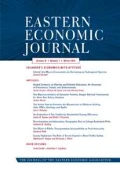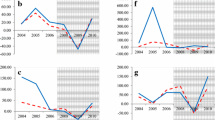Abstract
We analyze the impact on growth of cross-border mergers and acquisition (M&A) sales. Using the GMM methodology we find that most economies benefit from financial service M&A sales. However, some type of capital flows may hurt growth. In some cases M&A sales in manufacturing and the primary sector may lead to deindustrialization in manufacturing industry and/or services industries.
Similar content being viewed by others
Notes
Throughout the paper we use the term “spillover” loosely and do not distinguish between spillovers due to change in factor productivity, knowledge/technology diffusion or scale economies. We term spillover any such externalities that MNEs introduce in the host country, which affect sectoral growth rates.
See De Mello [1997, 1999] for an overview of the earlier literature and Lim [2001], Doytch [2005] and Crespo and Fontoura [2007] for a survey of the more recent literature.
For panel data estimation of the growth models see Islam [1995], Durlauf et al. [2004].
See Acemoglu et al. [2004] for a thorough survey of the literature on the role of institutions and economic growth.
We thank an anonymous referee for alerting us to this point.
International Standard Industrial Classification (ISIC), revision 3.
The country list is as follows: Full Sample: Argentina, Armenia, Australia, Austria, Bangladesh, Bolivia, Brazil, Bulgaria, Canada, Chile, China, Colombia, Costa Rica, Cyprus, Czech Republic, Denmark, Ecuador, El Salvador, Estonia, Finland, France, Germany, Honduras, Hong Kong, China, Hungary, Iceland, India, Indonesia, Ireland, Israel, Italy, Japan, Kazakhstan, Republic of Korea, Malaysia, Mexico, Morocco, Myanmar, Netherlands, Norway, Pakistan, Paraguay, Peru, Philippines, Poland, Portugal, Russian Federation, Singapore, Spain, Sweden, Switzerland, Thailand, Tunisia, Turkey, Uganda, United Kingdom, United States, Venezuela, RB, Vietnam. LAC: Argentina, Bolivia, Brazil, Chile, Colombia, Costa Rica, Dominican Republic, Ecuador, El Salvador, Honduras, Mexico, Paraguay, Peru, Venezuela, RB. WEE: Armenia, Austria, Bulgaria, Cyprus, Czech Republic, Denmark, Estonia, Finland, France, Germany, Hungary, Iceland, Ireland, Italy, Kazakhstan, Netherlands, Norway, Poland, Portugal, Russian Federation, Spain, Sweden, Switzerland, Turkey, United Kingdom. South & East Asia and the Pacific(SEAP): Australia, Bangladesh, China, Hong Kong, China, India, Indonesia, Japan, Republic of Korea, Malaysia, Myanmar, Pakistan, Philippines, Singapore, Thailand, Vietnam.
References
Acemoglu, Daron, Simon Johnson, and James A. Robinson . 2004. Institutions as the Fundamental Cause of Long-Run Growth, NBER WP 10481.
Aitken, Brian, and Ann Harrison . 1999. Do Domestic Firms Benefit from Direct Foreign Investment? American Economic Review, 89 (3): 605–618.
Alfaro, Laura, Areendam Chanda, Sebnem Kalemli-Ozcan, and Selin Sayek . 2003. FDI Spillovers, Financial Markets and Economic Development, IMF Working Paper 03/186.
Blalock, Garrick, and Paul J. Gertler . 2003. Technology from Foreign Direct Investment Welfare Gains through the Supply Chain, Working Paper, Department of Applied Economics and Management, Cornell University.
Blomstrom, Magnus, Robert Lipsey, and Mario Zejan . 1994. What Explains Developing Country Growth? in Convergence of Productivity: Cross-National Studies and Historical Evidence, edited by William, J. Baumol, Richard Nelson and Edwards N. Wolff, 243–259.
Blundell, Richard, and Stephen Bond . 1998. Initial Conditions and Moment Restrictions in Dynamic Panel Data Models. Journal of Econometrics, 87 (1): 115–143.
Borensztein, Eduardo, Jose De Gregorio, and Jong-Wha Lee . 1998. How Does Foreign Direct Investment Affect Economic Growth? Journal of International Economics, 45: 115–135.
Calderon, César, Norman Loyaza, and Luis Serven . 2004. Greenfield FDI and M&A: Feedback and Macroeconomic Effects, World Bank Policy Research, Working Paper 3192.
Chen, Chunlai, and Christopher Findlay . 2003. A Review of Cross-border Mergers and Acquisitions in APEC Asian. Pacific Economic Literature, 17 (2): 14–38.
Crespo, Nuno, and Maria Paula Fontoura . 2007. Determinant Factors of FDI Spillovers — What do we Really Know? World Development, 35 (3): 410–425.
De Mello Luiz. 1999. Foreign Direct Investment-Led Growth: Evidence from Time-Series and Panel Data. Oxford Economic Papers, 51: 133–151.
De Mello, Luiz R. 1997. Foreign Direct Investment in Developing Countries and Growth: A Selective Survey. The Journal of Development Studies, 34 (1): 1–34.
Doytch, Nadia 2005. Capital Flows and Growth: A Survey of the Empirical Evidence, CUNY Graduate Center, Unpublished manuscript.
Doytch, Nadia, and Merih Uctum . 2011. Does the Worldwide Shift of FDI from Manufacturing to Services Accelerate Economic Growth: A GMM Estimation Study. Journal of International Money and Finance, 30: 410–427.
Durlauf, Steven N., Paul.A. Johnson, and Jonathan R.W. Temple . 2005. Growth Econometrics. in Handbook of Economic Growth, edited by Philippe Aghion and Steven Durlauf 1st ed. Vol.1, chapter 8.
Gorg, Holger 2000. Analyzing Foreign Market Entry: The Choice Between Greenfield Investment and Acquisitions. Journal of Economics Studies, 27 (3): 165–181.
Gorg, Holger, and Eric Albert Strobl . 2001. Multinational Companies and Productivity Spillovers: A Meta Analysis. Economic Journal, 111 (475): F723–F739.
Haskel, Jonathan, Sonia Pereira, and Matthew Slaughter . 2002. Does Inward Foreign Direct Investment Boost Productivity of Domestic Firms?, NBER Working Paper #8724, Cambridge, MA.
Islam, Nazrul 1995. Growth Empirics: A Panel Data Approach. Quarterly Journal of Economics, 110 (4): 1127–1170.
Levine, Ross, and David Renelt . 1992. A Sensitivity Analysis of Cross-Country Growth Regressions. American Economic Association, 82 (4): 942–963.
Lim, Ewe-Ghee 2001. Determinants of and the Relation between Foreign Direct Investment and Growth: A Summary of the Recent Literature, IMF Working Paper No. 01/175.
Lipsey, Robert E. 2003. Foreign Direct Investment, Growth, and Competitiveness in Developing Countries, in The Global Competitiveness Report, 2002–2003, edited by Peter Cornelius. New York: Oxford University Press.
Lipsey, Robert E. 2004. Home- and Host-Country Effects of Foreign Direct Investment, in Challenges to Globalization, edited by Robert E. Baldwin and L. Alan Winters. Chicago: University of Chicago Press.
Neto, Paula, António Brandao, and António Cerqueira . 2008. The Impact of FDI, Cross-Border Mergers and Acquisitions and Greenfield Investments on Economic Growth, FEP WP, No. 291, Universidade de Porto.
Roodman, David 2006. How to do xtabond2: An Introduction to “Difference” and “System” GMM in Stata, Center for Global Development, WP #103.
Rossi, Stefano, and Paolo F. Volpin . 2004. Cross-Country Determinants of Mergers and Acquisitions. Journal of Financial Economics, 74 (2): 277–304.
Ruud, Paul A. 2000. Classical Econometrics. New York: Oxford University Press.
UNCTAD, World Investment Report 2004. The shift toward services.
Vasconcellos, Geraldo M., and Richard J. Kish . 1996. Factors Affecting Cross-Border Mergers and Acquisitions: The Canada-US Experience. Global Finance Journal, 7 (2): 223–238.
Very, Philippe, and David M. Schweiger . 2001. The Acquisition Process as a Learning Process: Evidence from a Study of Critical Problems and Solutions in Domestic and Cross-Border Deals. Journal of World Business, 36 (1): 11–31.
Acknowledgements
We would like to thank an anonymous referee for invaluable comments, which improved the manuscript substantially and the participants at the Eastern Economic Association, New York, 2009, as well as the participants at the Research Forums Seminar Series at University of New Haven. The second author gracefully acknowledges PSC-CUNY grant #61841-00 39.
Author information
Authors and Affiliations
APPENDIX
APPENDIX
DATA, DEFINITIONS AND SOURCES
Primary Source: World Development Indicators (2005)
Secondary Source: Economic Intelligence Unit report.
-
GDP per capita: gross domestic product (current USD divided by midyear population;
-
Industry value added per capita growth rates: industry annual growth rate minus population annual growth rate;
-
Gross fixed capital formation (current USD) as a share of GDP: includes land improvements (fences, ditches, drains and so on); plant, machinery and equipment purchases; and the construction of roads, railways and the like, including schools, offices, hospitals, private residential dwellings and commercial and industrial buildings (according to the 1993 SNA, net acquisitions of valuables are also considered capital formation);
-
Real lending interest rate: the rate charged by banks on loans to prime customers net of the annual inflation rate, measured by the GDP deflator.
-
GDP deflator: the ratio of GDP in current local currency to GDP in constant local currency (base year varies by country);
-
General government final consumption expenditure (formerly general government consumption) as a share of GDP: includes all government current expenditures for purchases of goods and services (including compensation of employees) and most expenditure on national defense and security, excluding government military expenditures that are part of government capital formation divided by GDP in current USD;
United Nations Educational, Scientific and Cultural Organization and World (website); Development Indicators (various years)
-
Secondary school enrollment ratio: the ratio of total enrollment, regardless of age, to the population of the age group that officially corresponds to the level of education shown;
International Country Risk Guide reports
-
Government stability: an index from 0 to 12 where an increase reflects an improvement.
Rights and permissions
About this article
Cite this article
Doytch, N., Uctum, M. Sectoral Growth Effects of Cross-Border Mergers and Acquisitions. Eastern Econ J 38, 319–330 (2012). https://doi.org/10.1057/eej.2011.16
Published:
Issue Date:
DOI: https://doi.org/10.1057/eej.2011.16




